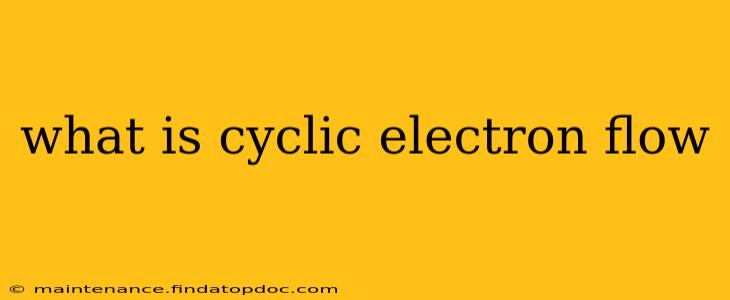Cyclic electron flow (CEF) is a crucial process in photosynthesis, particularly in plants and algae, that enhances the overall efficiency of energy production. Unlike the linear electron flow pathway, which produces ATP and NADPH, CEF focuses primarily on generating additional ATP. This extra ATP is vital for various cellular processes, especially those demanding high energy levels, like carbon fixation in the Calvin cycle. Let's explore this fascinating aspect of photosynthesis in detail.
What is the purpose of cyclic electron flow?
The primary purpose of cyclic electron flow is ATP synthesis. While linear electron flow generates both ATP and NADPH, the ratio produced isn't always optimal for the needs of the cell. The Calvin cycle, for example, requires more ATP than NADPH. CEF addresses this imbalance by providing a supplementary source of ATP without increasing NADPH levels. This refined control over ATP production is essential for efficient photosynthetic function under varying environmental conditions.
How does cyclic electron flow work?
Unlike linear electron flow, which involves photosystem II (PSII) and photosystem I (PSI) sequentially, CEF utilizes only PSI. Electrons excited in PSI are passed down an electron transport chain, eventually returning to PSI. This cyclical movement of electrons is the origin of the term "cyclic electron flow." As electrons move through this chain, protons (H+) are pumped across the thylakoid membrane, creating a proton gradient. This gradient then drives ATP synthesis via chemiosmosis, a process that uses the energy stored in the proton gradient to power ATP synthase.
What are the components involved in cyclic electron flow?
Several key components participate in cyclic electron flow:
- Photosystem I (PSI): The central component, where electrons are initially excited and then cycled.
- Ferredoxin (Fd): A protein that acts as an electron carrier, transferring electrons from PSI to other components in the chain.
- Plastoquinone (PQ): Another electron carrier that participates in proton pumping across the thylakoid membrane.
- Cytochrome b6f complex: A protein complex embedded in the thylakoid membrane that contributes to proton pumping and electron transfer.
- ATP Synthase: The enzyme responsible for ATP synthesis, driven by the proton gradient generated during CEF.
What is the difference between cyclic and linear electron flow?
The key differences between cyclic and linear electron flow lie in their components, products, and overall function:
| Feature | Cyclic Electron Flow | Linear Electron Flow |
|---|---|---|
| Photosystems | Only PSI | PSII and PSI |
| Products | ATP only | ATP and NADPH |
| Electron Path | Cyclical | Linear |
| Purpose | ATP supplementation | ATP and NADPH production |
How is cyclic electron flow regulated?
The regulation of cyclic electron flow is complex and not fully understood. However, it's believed to be influenced by factors such as:
- Light intensity: Higher light intensity can stimulate CEF to dissipate excess light energy and prevent photodamage.
- Redox state of the plastoquinone pool: The availability of electrons within the plastoquinone pool influences the flow of electrons through the cyclic pathway.
- Energy demand: The need for additional ATP in the cell, particularly for the Calvin cycle, may trigger the activation of CEF.
What are the benefits of cyclic electron flow?
The benefits of cyclic electron flow include:
- Enhanced ATP synthesis: Provides extra ATP to meet cellular demands, particularly those of carbon fixation.
- Protection against photoinhibition: Helps dissipate excess light energy, preventing damage to the photosynthetic machinery under high light conditions.
- Improved photosynthetic efficiency: Optimizes the balance between ATP and NADPH production, maximizing the overall efficiency of photosynthesis.
In conclusion, cyclic electron flow is a vital process in photosynthesis, playing a critical role in optimizing energy production and protecting the photosynthetic apparatus from damage. Its precise regulation ensures that the plant can efficiently utilize light energy under diverse environmental conditions. Understanding CEF provides valuable insight into the intricate mechanisms that drive life on Earth.
